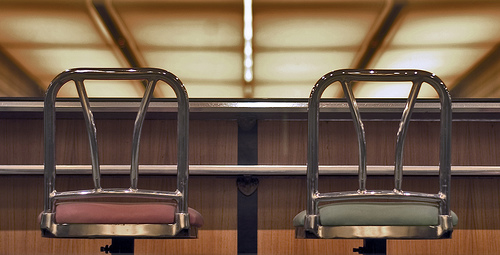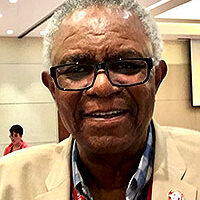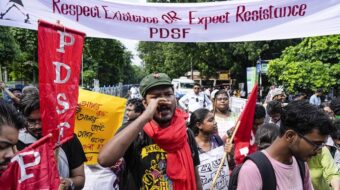
It’s hard to believe it has been 50 years since the four African-American students from North Carolina A&T College decided to go to the downtown Greensboro F. W. Woolworth’s store and stage a sit-in against the segregated lunch counter. It was done almost on a whim. Four 17-year-old Black college freshmen, Joseph A. McNeil, Franklin E. McCain, David L. Richmond, and Ezell A. Blair Jr. – all students at all-Black A&T College in Greensboro – were sitting around having a “bull session” when they decided to go to the South Elm Street five and dime store and challenge 82 years of entrenched Jim Crow segregation.
It was January 1960 and I was just one year out of high school in Philadelphia, working a low-paid factory job when the sit-in started. In my circle of friends, none of us were particularly political, but we were very moved by what our young contemporaries had done down in North Carolina.
Most of our parents had been raised in the South and like a lot of the children in our neighborhood, my brother, sister, and I had spent part of our summers with relatives in the South. Growing up in the Mill Creek Ghetto of West Philly we knew what racism was but we had also experienced the more oppressive intimidation and indignities of life in the Jim Crow South.
We were old enough to have seen the pictures of the horrible murder of 14-year-old Emmett Till in 1955. He was our age – in fact, he was born the same year and month as I was
My five close friends had all gone to predominantly Black schools and lived in predominantly Black neighborhoods. When we reached West Philadelphia High School we were in the minority. The school was rapidly becoming majority Black. But in 1956 my class was majority white.
Our everyday life in high school was full of the stresses and strains of adolescence made worse because we had to adjust to this new interracial environment. Most of us were basically trying to live and let live while we got our education. There were the occasional racist remarks by a teacher and clearly some of the white teachers openly favored the white students. This was the way it was. A Black student usually had to fight his or her way into the inner circles to gain access to advantages some of the white students received routinely.
And there was a serious incident when a large group of Black students from our school went to Hershey, Pa., for a picnic and were attacked by a white racist mob. The students had to run for their lives.
Our school was not formally segregated and as a freshman, most of my classes were integrated. There existed an unofficial system of racial tracking that meant only a small percentage of Black students were encouraged to become a part of the college-bound groups. Some had to fight their way in. That was a form of de facto discrimination. That‘s the way we saw it, anyway.
But as the school became more integrated, Black and white friendships tended to grow. We all ate in the same lunchroom but usually at different tables. We all went to the same prom and other social and sports events but there was a certain division along racial lines there too, and certainly, the after-parties were not mixed. Nevertheless, some real friendships did develop across racial lines. I had some good friendships with a few white schoolmates and in my senior year I attended one or two interracial house parties.
Considering what we were going through every day, when the struggle to integrate Little Rock High School took place (1957) it hit close to home. All my friends followed it closely and I imagined many of my white schoolmates did too. It was a frightening thing to see the racist mobs and the violent attacks. At Little Rock High there was a racist boycott of the school and it was overwhelming: few or perhaps no white kids came to school. After one violent incident in Little Rock, I remember one of my best friends asked what I assume was a rhetorical question. “Why,” he asked, “do they hate us so much?” None of us had an answer. The one thing we did know was, despite all the shortcomings and problems, we did not want our high school to become a tragedy like Little Rock High.
That same year the movie “Island in the Sun,” starring Harry Belafonte, Joan Fontaine, and Dorothy Dandridge, premiered. From the ads, everybody thought there would be a steamy romance between Belafonte (Black) and Fontaine (white). Eager to witness this anti-racist breakthrough for U.S. movies. a lot of the Black students played hooky and went to see the film. When we got to the theater we were surprised to see that a fairly good number of our white classmates had also skipped school to see this movie. As it tuned out the “love” scenes between Belafonte and Fontaine were sanitized and only hinted at a physical attraction between the two. Yet it was encouraging to see that the white students were also curious to see what would happen.
But while Emmett Till and Little Rock were not the whole picture, it seemed to us that Black people were mainly being victimized by the racists. Those experiences suggested that standing up to racism meant your life was in danger.
Greensboro was different.
When we saw the bold resistance of the young people in Greensboro who had the courage to stand up and do something about racism and had found the winning tactics, we were inspired and wanted to find a way of supporting them.
There had been other sit-ins at lunch counters around the South before Greensboro, but none had gained the momentum and mass support that Greensboro did.
Reportedly there was a Black woman serving behind the counter who told the students, “Fellows like you make our race look bad.” She then refused to serve them. She was wrong. Those four freshmen were uplifting our race and really the entire nation by their bold actions.
The four young men returned the next day. By the third day, the word had spread and 80 people showed up to sit in. Within a week over 1,000 pro and anti demonstrators filled the store. The movement was spreading all over the state, and into neighboring states. By the end of February, sit-ins were happening in 31 southern cities across eight states. By the end of March, sit-ins had spread to 55 cities in 13 states. A real mass movement was being born.
In a matter of days, veteran civil rights leaders had come to Greensboro to help the effort. According to Taylor Branch’s seminal history of the civil rights movement, “Parting the Waters,” Floyd McKissick then the head of the NAACP Youth Councils, and the Rev. Douglas Moore from Durham, rushed to Greensboro when they heard about the sit-in. The vice president of the National Students Association who heard about the sit-in was in Greensboro the next day.
After the third day, the Rev. Moore called James Lawson in Nashville for help. The word was spread to civil rights circles all over the South. Many responded including Wyatt T. Walker, Fred Shuttlesworth, Ella Baker, and the Rev. Martin L. King. Rev. Shuttlesworth told Ella Baker to be sure to tell Dr. King that “we must get with this.” Shuttlesworth predicted that the sit-ins would “shake up the world.”
Speaking at a rally in support of the sit-ins, Dr. King declared, “Men are tired of being trampled over by the iron feet of oppression.” He added, “The underlying philosophies of segregation are diametrically opposed to democracy and Christianity, and all the dialectics of all the logicians in the world cannot make them lie down together.” In his strong endorsement of the sit-in movement, he said, “What is fresh, what is new in your fight is the fact that it was initiated, led, and sustained by students. What is new is that American students have come of age. You now take your honored place in the worldwide struggle for freedom.” (“Parting the Waters,” pp. 275-276).
That’s how important the Greensboro sit-ins on Feb. 1, 1960, were. That struggle gave birth to the massive student protest movement of the ’60s. The Student Nonviolent Coordinating Committee was born out of that struggle. The Freedom Rides to protest segregated public accommodations in interstate travel were kicked off in 1961.
In May 1960 students at Berkeley demonstrated at the House Un-American Activities Committee hearings in San Francisco and were shoved, beaten, and fire-hosed because they refused to be kept out of the hearings. Over 1,000 predominantly white students took part in that protest. Longshore leader Archie Brown and African-American activist Juanita Wheeler were called before the committee and refused to cooperate. They both were physically thrown out of the hearings by the police. That struggle was a turning point in the movement against the anti-communist repression that dominated the 1950s and the beginning of the Free Speech Movement.
I started out the 1960s with a low-paid factory job but soon became a union member. At the same time, I found the civil rights and youth movement in my West Philadelphia community. The movement became a lifelong commitment for me.
Those four young students who, as Dr. King put it, grew tired of being trampled on, went out and sparked a movement that was part of a great democratic revolution that transformed our nation into something better. While racism remains, as well as deep-going class oppression, that great movement of the ’60s decade helped make this a far more democratic humane society.
In that movement, I also found the Communist Party USA, but that is the subject of another article.
Photo: Two of the four stools at the Woolworth’s counter originally in Greensboro, N.C. Displayed in the National Museum of American History, Washington. http://www.flickr.com/photos/scfiasco/ / CC BY 2.0












Comments